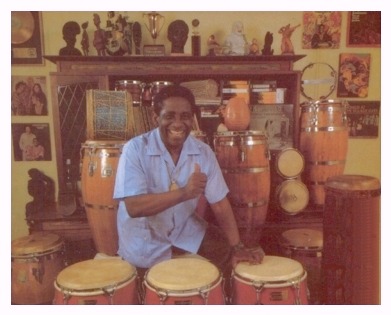RAMON 'MONGO' SANTAMARIA
Legendary master conguero, bongocero, band leader,
composer
Born in Havana, Cuba April 7, 1917
Died in Miami, United States February 2, 2003

Ramon 'Mongo' Santamaria grew up in the Jesus Maria district, a working
class neighbourhood in Havana with deep African roots. He was brought
up by his mother as his father died young, and received the nickname 'Mongo'
which he later learned meant 'chief of the tribe'. Due to his mother’s
insistence he studied the violin for a time, but his love for hand percussion
was such that it became his lifelong passion. He was inspired by
Chano Pozo, the legendary Cuban conga player who migrated to the United States and
had a brief but remarkable career playing with Dizzy Gillespie.
In pre-Castro Cuba, Santamaria worked all the major nightclubs, places
such as the famous Tropicana, before heading for Mexico in the late 1940s
with an ensemble of dancers and musicians led by Pablito Duarte. Soon after, Santamaria made his move to the United States where he joined Perez Prado’s
Orchestra and enjoyed enormous success in the mambo era of the early 1950s. He then worked extensively with Tito Puente performing and recording with
his band — the highlight being two memorable percussion albums: Top Percussion and Tito in Percussion.
He left Puente in 1957 to join Cal Tjader’s quintet in California. This
move was to prove extremely important for Santamaria as he was keen to
expand his musical expertise and to perform to new audiences. His work
with Puente had been geared exclusively towards dancers, while Tjader’s
group played for listeners and was featured in jazz clubs, concerts and
college campuses.
He started his career as bandleader in the 1960s with his charanga band La Sabrosa which laid some of the foundations for the now popular salsa
style. In 1963 while recording the Herbie Hancock tune Watermelon
Man, he coloured his sound with a rhythm and blues tinge and had a hit
on the pop charts. The tune reached the Billboard Top Ten Hit list;
it was the first major Latin crossover pop hit.
He often said the best rhythms come from 'skin on skin'. He recorded
his first percussion based album Drums and Chants in the early 1950s,
and followed that with releases such as Yambu, Mongo, Our Man In Havana,
Bembe and Up From The Roots. These recordings continue to inspire generations. His most famous composition Afro Blue, a beautifully crafted tune with
a strong 6/8 African rhythmic connection, has become a jazz standard. The piece has been covered several times with some memorable versions recorded
by John Coltrane, Dianne Reeves, Tito Puente, Dave Valentin and Cal Tjader.
Santamaria possessed unique talents as a percussionist and had a visionary
outlook as band leader. His music contains a unique combination of
Latin, jazz, soul and rhythm and blues. As band leader he also had
an incredible foresight in choosing and encouraging up and coming talents. Some of his former sidemen include pianists Chick Corea and Herbie Hancock,
flautist Hubert Laws and trumpeter Luis Gasca. Santamaria recorded
more than seventy albums as leader, and was signed at one time or another
to some of the most prestigious record companies in the world including
Fantasy, Columbia, Atlantic, Concord, Riverside, Milestones and Fania. He received five Grammy Award nominations and in 1997 his album Amanecer was awarded the Grammy for Best Latin Recording.
Santamaria was one of the finest individuals to grace the world of percussion,
and as far as conga playing, arguably the most influential. Players
of many generations and of wide cultural backgrounds worldwide always make
a mention of Santamaria’s profound influence. He left Cuba determined
to make a mark in the international music scene, something he achieved
in his lifetime. His music will live on forever. May he rest
in peace.
© Alex Pertout. All rights reserved. No part of this article
may be reproduced without prior written permission from the author. This article was first published in The Age Obituaries (February 11, 2003) and in Drumscene magazine.
|

